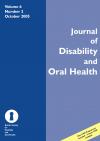Journal of Disability and Oral Health

- Cover Date:
- August 2006
- Print ISSN:
- 1470-8558
- Electronic ISSN:
- 1754-2758
- Vol:
- 7
- Issue:
- 2
Poster Presentations
P01:01 Longterm effects after treatment of dental phobia, results from a multiple choice questionnaire
R. Thorman1, O. Dahllöf2, E. Kahlmann3, E. Björkman3, Public Dental Service, Stockholm1, Reg. Psychologist2, Reg. Dentist3, Public Dental Service Dept of Oral Medicine, Sweden. royne.thorman@ftv.sll.se Aims: For more than 20 years, efforts have been made to find ways of helping adult patients to overcome their dental phobia. The Stockholm model consists of a cognitive therapy programme helping the individual to overcome the anxiety and find tools to cope with the dental treatment sessions. The aim of this poster is to present a long term evaluation of a treatment process practised at the clinic. Methods: A multiple choice questionnaire was sent out to 120 patients. The questionnaire contains 10 questions. Statements where made after each guest ion to be validated on a scale of one to five, with one symbolising that the patients agree very little. Questions were asked to find out the patient’s attitude towards the programme, clinicians, reason for phobia and the progress to handle fear. The patients have all attended the programme and been referred to a community practise for ordinary dental treatment. Results: We hope to find facts describing weaknesses of the programme as well as the strengths. Through collection of information from patients we will be able to measure how many percent of the group continued for recall appointments. There will be facts showing whether dental phobia is still a problem for the individuals and if so, how it is manageable. Conclusions: Dental phobia is a handicap for as many as 5% of the population in Sweden. The questions answered will give us new tools to understand how to optimise the therapy of dental phobia. We also try to evaluate if the programme is efficient from a cost benefit point of view. R. Thorman1, B. Hylander2, Public Dental Service, Stockholm1, Dept of Renal Medicine, Karolinska Hospital Solna, Sweden2. royne.thorman@ftv.sll.se Objectives: The first report of possible oral complications to uraemia was published in 1975. Later studies have confirmed findings of oral disease in combination with renal dysfunction. The majority of uraemia patients will never be accepted for renal transplant because of medical conditions and lack of kidney grafts. The oral cavity contains a wide range of microbes, mostly considered as a normal flora, but harmful when the patients progress in their disease. Methods: A multiple choice questionnaire was sent out in Sweden through mail to 337 patients. The answers describe the group according to social status, medical complexity, earlier and ongoing medication and uraemic treatment. The patients were also asked about their oral condition. Results: 232 (69%) patients a n s w e r e d , 59% were males and 41% were women. The patients attended different treatments such as, haemodialysis (15%), peritoneal dialysis (9%), transplant (62%) and other treatments (10%). Social status, other diseases and disabilities where described. The patients’ drug treatments at the time of answer and earlier are presented. As many as 70% of the patients had oral problems of some kind. Conclusions: The aim of this study is to describe the patients due to degree of uraemic disease, medication and oral health as described by the patients. Evaluation of the questionnaire makes it obvious that further clinical research and causes of complications in the oral cavity needs to be investigated.
- Article Price
- £15.00
- Institution Article Price
- £15.00
- Page Start
- 96
- Page End
- 131
- Authors
Articles from this issue
- Title
- Pg. Start
- Pg. End
